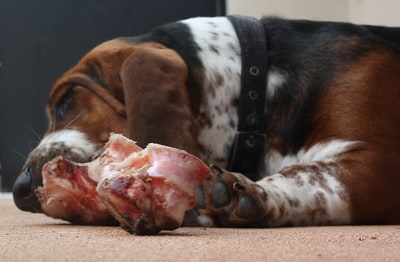You know that guilty feeling you get when your dog begs for any leftover steak? You cannot give him that, but pork shoulder bones are safe and quite healthy for your dog.
Cooked bones are dangerous as heat-processing makes them brittle, but raw bones should pose no problem to your dog. Pork shoulder bones are highly-nutritious and fun to gnaw on.
If you’re worried your dog might get infected with various parasites from the raw pork, we have an easy solution to make the bones perfectly safe for consumption.
As for what other bones should be safe for a dog, make sure to always look for large weight-bearing bones, especially beef legs.
What you will learn from this article
- Why are the advantages for a dog to eat pork shoulder bones?
- Raw vs cooked pork shoulder bone
- What is the possibility of the pork being infected?
- What are other safe, weight bearing bones that a dog can chew on?
- What are some of the most dangerous bones to let your dog chew?
- How else can you use a pork shoulder bone with your dog?
- How long should you let a dog chew a bone?
- What are the best chew toys for dogs that aren’t animal bones?
- Closing Thoughts
Why are the advantages for a dog to eat pork shoulder bones?
The obvious reason pet owners would like to give their dog pork shoulder bones is that they’re easily available and affordable.
And, of course, you know your dog would really like to sink his teeth in a nice juicy bone.
Pork shoulder bones are generally safe for dogs and they’re highly nutritious as they provide a lot of protein and your pet needs that.
A pork shoulder bone has 11% protein and only 3% fat. They’re also a great source of calcium, which is important for dogs of all ages.
What makes pork shoulder bones better than many other types of bones is that they’re large weight-bearing bones.
A large bone gives your dog plenty to gnaw on and you don’t have to worry it will break easily.
A big dog can apply a lot of force and break smaller bones, which puts him at risk of swallowing splinters that may do a lot of internal damage.
Raw vs cooked pork shoulder bone
When it comes to feeding your dog bones of any kind, the rule is to always present them raw. Never cooked.
No matter how you cook a bone, it becomes dry and brittle in the process and it tends to splinter easily. Your dog will see that as a major victory and will gladly swallow every splinter big or small. The immediate danger is that a bone splinter becomes lodged in the dog’s throat and the animal might choke in front of your eyes. On the other hand, if the splinter makes its way through the esophagus it can puncture the stomach or create an intestinal obstruction. Both are medical emergencies and left untreated they can kill a dog.
This is the reason why you shouldn’t feed your dog leftovers from the dinner table.
Also, you need to know that even boiled bones become dry and brittle so they’re no better than grilled bones.
If you want to make your dog happy and let him have a good chew, give him raw bones.
What is the possibility of the pork being infected?
Many pet parents will be horrified at the idea of feeding their dog raw pork. Even undercooked pork is dangerous for both humans and dogs, as the meat might be infected with various parasites.
Pigs can carry both heartworms and roundworms, but what you should worry most is trichinella spiralis, a parasite that causes trichinosis, a potentially serious gastrointestinal disease.
Your dog might get an upset stomach, with a lot of vomiting and diarrhea.
In severe cases, a dog with a weaker immune system might become lethargic and you’ll notice some stiffness when he moves, a sign that he’s in serious pain.
Fortunately, there’s an easy way to avoid such an infection by simply freezing pork meat and bones for at least 3 weeks.
If you have a large freezer, buy a few large pork shoulder bones and leave them there for a few weeks.
This kills parasites and the bone should now be safe for your dog. The best part is that your dog will probably appreciate the bone served straight from the freezer, especially on a hot day.
What are other safe, weight bearing bones that a dog can chew on?
Dogs need to be able to satisfy their natural chewing instinct, a pastime that provides mental stimulation and helps with oral hygiene, but safety should be your primary concern.
Always try to offer your dog large weight bearing bones.
Besides large pork bones, a dog can safely chew on beef legs or bison legs, which are full of a highly-nutritious and much appreciated bone marrow.
Find a reliable butcher in your area and ask them to cut the hard beef legs into marrow bones and knuckle bones, so your dog can have plenty of fun.
Even puppies can benefit from chewing on a marrow bone.
Bone marrow is full of healthy fats which helps with brain development.
Knuckle bones and beef knee caps can be consumed completely. They’re made of cartilage, soft tissue and rounded bones that won’t cause mouth or throat injuries.
There’s a lot of debate on whether a dog should be allowed to eat pork or beef ribs. These should probably be safe if fed raw.
However, whenever you’re giving your dog a bone to chew on, make sure to keep an eye on him at all times.
What are some of the most dangerous bones to let your dog chew?
Chicken bones are considered unsafe for dogs as they can easily splinter. This is true for leg bones or ribs. However, chicken wings and neck bones can be consumed by a dog safely.
The same goes for turkey bones, they break easily.
As a rule, the bones should be longer than the dog’s muzzle or approximately as big as the dog’s head, so he has something to chew on, but something he won’t break and swallow the chunks. If the bone is smaller than the dog’s head, he might swallow it whole and again you have the risk of choking or bowel obstruction.
How else can you use a pork shoulder bone with your dog?
If you’re wary of feeding your dog raw bones, you can make a nice bone broth so your pet will get all those good nutrients without any risks.
You can use pork, beef or poultry bones, basically whatever you have around your kitchen. To make a nutritious bone broth you should use a slow cooker and let the bones simmer for at least 24 hours. You can also add one or two tablespoons of apple cider vinegar which helps extract all the good nutrients in the bone marrow.
To make the broth even better, throw in a few vegetables as well, like carrots or potatoes. No seasoning is needed and your dog won’t care, the meat flavor is enticing enough.
Strain the broth and you can store it in the fridge for a few days. Or you can make broth cubes in the freezer to be used as needed.
You can add a bit of broth to your dog’s regular meal, to make it healthier and more appealing, particularly if you have a picky eater.
Bone broth is a great source of collagen and gelatin, which promote joint health. This is a major problem for senior dogs. Gelatin is also important for a good digestion as it protects and restores gut lining.
How long should you let a dog chew a bone?
If you’re giving your dog a bone as a recreational treat, it’s best to do so after a meal. When the dog’s full he’ll be less aggressive in his chewing, which reduces the risks of the bone breaking.
Let the dog have fun with the bone for 10 – 15 minutes or until you see that he’s doing a very good job chewing on it to the point that the bone might break.
After 15 minutes take the bone away and, if it’s still usable, put it in the fridge and present it again the next day. After 3 – 4 days, throw the bone away to avoid the risk of it going bad.
What are the best chew toys for dogs that aren’t animal bones?
As tasty as they may be, recreational bones are not something you can give your dog every day. One of the problems is the fat in the marrow, which might be a bit too much if consumed daily.
If you have an energetic dog, you can find other toys and treats to satisfy his chewing instinct. You should, however, stay away from commercially available chew bones which might be safe as chewy toys, but not all that healthy. Check out the labels and you’ll understand why.
Try offering your dog bully sticks, which are made of beef muscle. Bully sticks are fully digestible and they won’t splinter.
At the same time, Kong toys are great as chew toys as they are made of hard rubber your dog won’t be able to break. Kong toys are even more fun if you fill them with nice dog treats.
Toys made of soft rubber are dangerous as the dog might bite and swallow big chunks.
Closing Thoughts
Pork shoulder bones are among the safest recreational bones for a dog. A dog needs to have something to chew on, but make sure to always offer him large weight-bearing bones which are hard enough and won’t splinter. Give your dog only raw bones. Cooked ones are too brittle and splinter easily. You can also use bones of any kind to prepare a super-healthy bone broth for your dog, and throw in some veggies as well.
If your dog gets bored easily, look for safe toys and treats for him to chew on, consume the extra energy and doze off!






